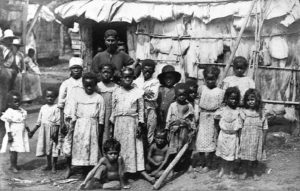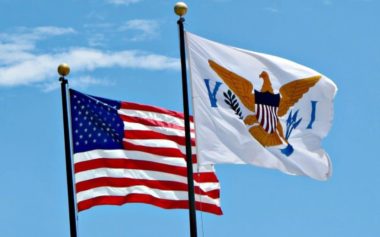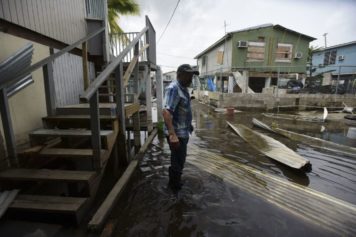
Puerto Rican children in 1898, the same year the United States took the island in conquest from Spain, reflect the land’s legacy as a former destination for imported African slaves. (Photo: Wikimedia Commons)
The post-hurricane devastation facing Puerto Rico and the U.S. Virgin Islands, and the lack of attention being paid by the federal government to necessary relief efforts. The lack of media attention to the death and destruction facing these U.S. citizens — who are not white and many of whom are of African descent — speaks to their second-class citizenship rooted in white supremacy and systemic racial discrimination.
With nearly half of Americans not realizing Puerto Ricans are U.S. citizens — and even Donald Trump apparently not realizing the people of America’s island territories are citizens, or that he is the president of the U.S. Virgin Islands — these Black and Brown territories are American colonies and possessions of conquest in every manner.
The reason why the island territories — not only the Caribbean islands, but also Pacific islands such as Guam and the Northern Mariana Islands — are subjected to separate and unequal treatment, and are not states, is because of the Insular Cases, a series of racist Supreme Court decisions, of which the first were written by the same court that gave us the endorsement of racial segregation in Plessy v. Ferguson. These cases established the racist framework governing nonwhite territories of the United States. The island territories, inhabited by so-called alien races, were designed to give the United States control over the seas but second-class citizenship to their inhabitants. These cases are why these Black and Brown territories — as opposed to former white-controlled territories turned states — are subjected to the control of Congress, and no territory has become a state since Alaska and Hawaii in 1959.
The Spanish-American War led to the acquisition of Puerto Rico, the Philippine Islands and Guam by the United States, at a time of substantial territorial expansion and imperialist aspirations, with the concept of “manifest destiny” and the subjugation of inferior races “for their own good.” These native populations were nonwhite, with different customs and languages from the dominant Anglo-Saxon culture, and the lands were noncontiguous to mainland America. In that regard, these territories were unlike the other territories that existed at the time, including Alaska, Arizona, New Mexico and Oklahoma, as was written in Slate.
At the time, Alaska and Hawaii had already been established as sovereign territories incorporated into the United States, with full constitutional safeguards and a pathway to statehood. The American court system rationalized that Alaska was in a different classification from Puerto Rico because it was on the North American continent. Hawaii, which the U.S. annexed in 1898, was a distant island populated by nonwhite people like Puerto Rico, yet Congress quickly granted full citizenship to its residents in 1900. Further, the United States was changing its definition of a territory, as Slate noted, opting for a European model of expansion to rescue the savages — a white supremacist message which presidents such as McKinley and Theodore Roosevelt endorsed. Further, President William Howard Taft — later Supreme Court Chief Justice — had a personal bias against Puerto Rican people which proved decisive in the fate of the territory. Taft believed they were unable to understand institutions of “Anglo-Saxon origin” such as the jury system, and he supported citizenship only if the territory was not granted statehood. The American attitude towards these nonwhite possessions reflected both the racism of the day, but also a desire to economically exploit these islands and establish military bases on them.
In one of the Insular Cases, DeLima v. Bidwell, the high court found that Puerto Rico was not a foreign country within the context of tariff laws. In Downes v. Bidwell, the court ruled that Puerto Rico was an unincorporated territory under the control of Congress, but without the full protection of the U.S. Constitution. “If those possessions are inhabited by alien races, differing from us in religion, customs, laws, methods of taxation, and modes of thought, the administration of government and justice according to Anglo-Saxon principles may for a time be impossible, and the question at once arises whether large concessions ought not to be made for a time, that ultimately our own theories may be carried out and the blessings of a free government under the Constitution extended to them. We decline to hold that there is anything in the Constitution to forbid such action,” the court wrote in its opinion.
In Gonzales v. Williams, the Supreme Court said that a woman from Puerto Rico who moved to New York was not an “alien immigrant,” but rather a “noncitizen national.” In 1917, Congress granted citizenship to people in Puerto Rico.
Formerly the Danish West Indies, the U.S. Virgin Islands became a United States territory in 1917, when the islands were transferred from Denmark for $25 million. Residents of the islands were granted full citizenship rights in 1932 through an act of Congress. Before that time, U.S. courts regarded the people of the U.S. Virgin Islands not as citizens but as “nationals,” which in U.S. colonial policy referred to “inhabitants of colonies to whom the rights of U.S. citizenship were not conferred.”
Although the inhabitants of the U.S. Virgin Islands and Puerto Rico received U.S. citizenship, the racist policies which undergirded America’s treatment of its colonial territories have persisted. This is why people from these islands, who are truly American, often are not regarded as such, particularly after a natural disaster.
Meanwhile, the PR crisis has the potential to change Southern politics, particularly in Florida, potentially giving Democrats an advantage. The states with the greatest influx of Puerto Ricans between 2007 and 2009 were, from highest to lowest, Florida, Pennsylvania, Texas, Massachusetts, Connecticut, Ohio, Georgia, North Carolina, Virginia and Maryland.
More than 1 million people of Puerto Rican descent live in Florida, doubling their number since 2001 as a result of a weak economy back home, and as many as 100,000 more are expected to relocate to the state as victims of Hurricane Maria. Leaning heavily Democratic and voting in large numbers, Puerto Rican voters in the mainland voted for Hillary Clinton by a 3-to-1 margin. The Puerto Rican diaspora in Florida and elsewhere, angered by Trump’s inaction in addressing the needs of the storm-ravaged island, and displaying a perceived insensitivity to their plight when he threw paper towels to a crowd during his visit, could galvanize and make a difference in the 2018 and 2020 elections. Although treated not unlike second-class citizens back home, where they cannot vote in national elections, Puerto Ricans on the mainland can register to vote anywhere and participate in races for the Senate, Congress and President, in what may prove the ultimate revenge.
This revenge is against Republicans and Trump — who ignores their plight post-Hurricane Maria and exhibits the racial bias of white U.S. leaders and policymakers a century ago. But this opportunity for payback by Puerto Rican voters also reflects an ability to impact politics on the mainland, after years of political exclusion and marginalization back home, and a colonial limbo status denying them statehood on the one hand, and independence and self-determination on the other.

